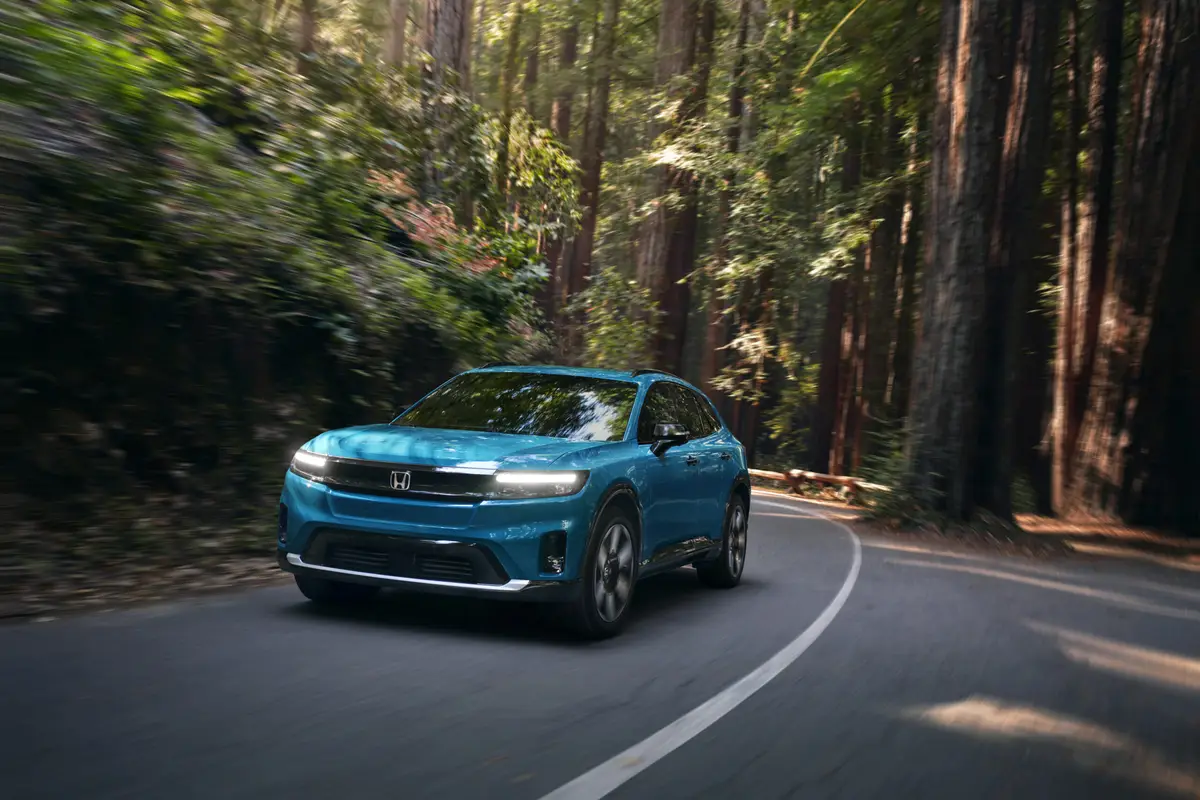Detroit Newspapers's view
The Isuzu Trooper, modestly updated for 1998, is a good- looking, competent, comfortable sport-utility vehicle with more power and a sophisticated four-wheel-drive system.
But if you’re among the many who guide your new-product purchases by reading Consumer Reports, you may have a scary mental image of a Trooper wobbling its way down a test track on two wheels.
In the course of evaluating a 1996 Trooper, a test driver managed to get the vehicle up on two wheels. The magazine passed out video clips of the tipsy Trooper at an August 1996 press conference in New York when it branded the truck “not acceptable” and called for a national recall of all 1995-96 Troopers and the nearly identical Acura SLX.
Television loves that kind of stuff, but is the Trooper really unsafe? I don’t think so, and here’s why:
I’ve been on test tracks with Troopers, doing the same kind of maneuver — a double-lane change — and I’ve never been up on two wheels.
Car and Driver magazine, certainly one of the most respected and technically authoritative of the automotive magazines, has performed the same test with the same results. No bicycling. And the Car and Driver test drivers slashed through the cones considerably faster than the Consumer Reports drivers, who got the Trooper up on two wheels at about 35 m.p.h.
Consumer Reports has had a history of surfacing with sensational test results almost guaranteed to grab media attention and create panic.
Remember the Suzuki Samurai?
Consumer Reports’ testing suggested that this tiny sport-utility was practically spring-loaded for rollovers. One false move and you’re inverted.
Suzuki eventually beat the rap, but by then the Samurai was pretty much dead meat in the marketplace.
Remember the Dodge Omni?
The Consumer Reports test staff concluded that if one were to turn the wheel hard to one side or the other while traveling more than 50 m.p.h., the car would flip.
Well, duh.
The truth is that with a little effort it’s possible to get any vehicle up on two wheels — or, if you prefer, its roof.
Sport-utilities require less effort than most. Extra ground clearance and a tall profile add up to a significantly higher center of gravity, which, in turn, makes it easier to tip them over.
Here’s the worst thing I can say about the double-lane-change performance of the ’95-97 Trooper/SLX: It was a bit slower through the cones than many of its direct competitors in the same test.
I suspect the ’98 Trooper would give a better account of itself in the same test, because it has substantially more power to augment recovery in quick directional changes. But I wasn’t able to put this theory to the test because the recent monsoon limited my testing.
Nevertheless, with or without more power, the National Highway Traffic Safety Administration found no merit in Consumer Reports’ contentions concerning the Trooper’s willingness to remain upright.
But vindication in situations like this never offsets the damage done to the manufacturer.
Consider Audi and the unintended acceleration witch hunt. The whole business was nonsense, and Audi was ultimately exonerated. But Audi’s North American sales went from robust to microscopic almost overnight and are only now beginning to recover.
Similarly, the Trooper’s sales took a major nosedive: 18,495 in 1996 to 10,964 in 1997.
Well, I think the combination of the NHTSA’s no-merit response to the Consumer Reports’ allegations and the ’98 improvements to the vehicle should help to get the Trooper back on track.
Power boost
The changes for ’98 include a new, more rounded look up front and, more important, a boost in power, plus an automatic four-wheel-drive system that’s far more flexible than the part-time hardware offered on the previous Trooper.
Let’s check the optional four-wheel-drive system first. Isuzu calls it To ue on Demand (TOD), and, like other automatic four-wheel-drive systems, it reapportions power from the rear wheels to the front when system sensors detect slippage at either end.
Our recent wet weather did give me a chance to give the TOD system some exercise, and it seems to function as advertised, providing an extra measure of grip on slippery freeway connector ramps and my favorite stretches of twisty rural roads.
And it’s also far more user-friendly than an old-fashioned, part-time system. Just punch a button on the dashboard — at any speed up to 60 m.p.h. — and the system goes to work.
Engaging low-range four-wheel drive still requires coming to a stop, putting the transmission in neutral and operating a separate shift lever for the transfer case.
But you’re not likely to need the extra traction unless you’re going into real off-road terrain.
If you do, you’ll find the Trooper to be a little above average in competence, thanks largely to its 8.5 inches of ground clearance, relatively compact 108.7-inch wheelbase and limited front overhang, the portion of the vehicle that extends beyond the centerline of the front axle.
Like its improved four-wheel-drive system, the Trooper’s extra power is a welcome upgrade.
The V6 engine has been expanded from 3.2 to 3.5 liters, raising horsepower from 190 to 215, and torque from 188 foot-pounds to 230.
The last number is the important one. Torque is the low-r.p.m. power commodity that induces motion in a stationary mass, and there’s lots of it here.
The Trooper weighs in at 4,540 pounds with the optional automatic transmission, and that’s one of the reasons the previous Trooper felt a little sluggish compared with its contemporaries.
The automatic is also equipped with two mode switches — Power and Winter — to temper power delivery to conditions. In the power mode, the transmission holds its shift points a little higher for better acceleration, while the winter mode holds them down to prevent wheel spin.
There are some detail elements that could still be improved.
More to improve
For one, the Trooper still retains its tailgate-mounted spare when most four-door sport-utilities have stowed the spare underneath.
A rear-mounted spare is certainly handier if you find yourself having to change a tire in the middle of some lonely puddle, and the Trooper’s mount is low enough so it doesn’t interfere very much with vision to the rear.
But rear-mounted spares are vulnerable in rear-end collisions. Even a minor punt from, say, another sport-utility vehicle is likely to bash in the rear doors.
Isuzu gave buyers a choice between the rear rack and an underbody spare with the new Rodeo, so it’s a little strange that the same choice isn’t available on the more expensive Trooper.
The Trooper’s rather firm on-road ride is another element that may not find favor with everyone, although I liked the positive sense of control and limited body roll — limited by sport-utility standards, that is.
I wish that the domestic trend toward oversize audio controls would become universal. The Trooper’s are still on the small side, although the sound-system quality was good, and low interior noise levels (again, by sport-utility standards) made it easier to appreciate the audio.
With a base price of $28,245, including $445 destination, an automatic Trooper (the standard five-speed is $1,250 less) is above average compared to other players in this class.
But it includes an above-average standard equipment list, as well as above average interior volume, and very good assembly quality.
My tester had a $2,180 Performance Package option, which included the Torque on Demand system (the basic Trooper comes with part-time four-wheel drive and the TOD system is available only with an automatic transmission); a limited-slip differential; body-colored bumpers; privacy l ss; dual map lights and outside mirrors with a foldaway feature.
That, plus a CD player ($650) and cargo net ($92) brought the as-tested price to $31,167.
All in all, a decent value, measured against the near-luxury end of this size class.
Personally, I prefer the extra V8 punch and macho presence of the Dodge Durango.
But the Trooper has a smooth, sophisticated presence of its own, as well as plenty of room.
And I don’t think you’ll have any trouble keeping all four wheels on the road.
SPECS
RATING: 3 wheels
VEHICLE TYPE: Front-engine, four-wheel drive compact sport-utility
KEY COMPETITORS: Chevy Blazer, Dodge Durango, Ford Explorer, Jeep Grand Cherokee, Nissan Pathfinder, Toyota 4Runner
BASE PRICE: $28,425
PRICE AS TESTED: $31,167
STANDARD EQUIPMENT: Four-wheel ABS, four-wheel drive, dual air bags, air-conditioning, power windows, power mirrors, keyless remote entry, AM-FM-cassette audio, tilt steering, cruise control, aluminum alloy wheels, skid plates
SPECIFICATIONS:
(manufacturer’s data)
Engine 215-h.p., 3.5-liter V6
EPA fuel econ. 15 m.p.g. city
19 m.p.g. highway
Curb weight 4,540 pounds
Wheelbase 108.7 inches
Length 183.5 inches
Width 72.2 inches
Height 72.2 inches
Assembled Fujisawa, Japan
THE TROOPER’S ROCKY ROAD
Here’s how the controversy about the safety of the Isuzu Trooper began, and what is happening now.
The October 1996 issue of Consumer Reports magazine included a road test of a 1996 Trooper, which concluded that the vehicle was prone to rollover accidents.
Consumers Union, which publishes the magazine, called on the National Highway Traffic Safety Administration (NHTSA) for a defect investigation and a recall of 1995 and 1996 Troopers, as well as the virtually identical Acura SLX.
Isuzu responded by questioning the validity of the Consumers Union short-course avoidance testing, which NHTSA had criticized in 1988, saying: “There appears to have been sufficient latitude to allow a driver, either knowingly or unknowingly, to influence the testing without readily being detected by the available instrumentation.”
The same NHTSA findings also concluded that the test procedures “cannot be linked to real-world crash avoidance needs or actual data.”
Isuzu also pointed out that Consumers Union had run 1988 and 1992 Troopers through the same tests without a problem, and that the only major difference in the 1996 model was a wider width between the wheels — which should make it less prone to rollovers rather than more.
The company concluded by noting that no injuries or fatalities had been recorded by the Trooper or SLX in rollover accidents.
After a study of the Consumers Union claims, plus engineering and test data submitted by Isuzu, NHTSA rejected the Consumers U nion petition in July last year.
Isuzu responded by filing suit against Consumers Union for defamation and product disparagement., The suit is still in progress.
Latest news



